Text
Ergo Proxy References and Parallelisms Vol. III
This post was supposed to be longer, but for "reasons" I guess it will be shorter than expected. My apologies for the rush.
On this Volume:
DARKMAN
WW2
Train Stations
FOLLOW THE WHITE RABBIT
Navigation Map
City of the Sun
Douglas Coupland
Bilbul
DARKMAN

Darkman (the 1990 superhero-horror film directed by Sam Raimi) belong to different genre, and dwells into different tropes, it was an atmospheric influence for Manglobe and the creators of Ergo Proxy. The idea of the erosion of a main character with an eroded identity lies in the DNA of both stories since Darkman's protagonist, Dr. Peyton Westlake, loses his physical identity after a brutal attack leaves him disfigured. He uses synthetic skin to assume different identities, but his transformation also leads to a psychological struggle with his sense of self.
Proxies as shapeshifters themselves are no strangers to the habit of taking a human appearance to coexists among their creations. Vincent Law is the very well crafted human suit of a meek personality, antipodal to his more insightful but aggressive true nature as Ergo Proxy. Yet, even as a human, Vincent struggles to get to be accepted in Romdeau's Society.
On Meditatio XIV, the Proxy regent of Ophelia used his ability to shapeshift to create multiple identities for himself, and so, blend into society by taken multiple identities.
WW2
Not only the uniforms and vehicles, but the weapons of the survivor soldiers at Xharos Dome on Meditatio VIII remind us to the latest installment of Word War in our history.
At a point, a soldier has what is very reminiscent of a Walter P38, a 9 mm semi-automatic pistol that was developed by Carl Walther GmbH as the service pistol of the Wehrmacht at the beginning of World War II.

Meditatio VIII

C&S Detective Special 2()19
One of the Weapons that Re-L Mayer uses is a C&S Detective Special 209.

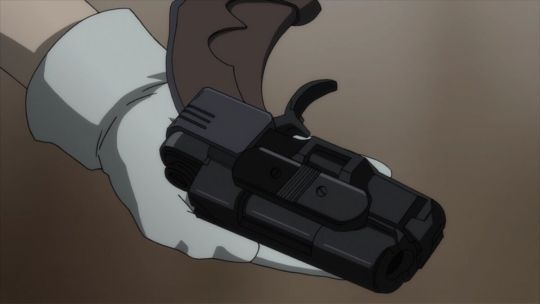
This Weapon also dubbed as the "Proxy Killer" can be loaded with the FP bullets that have the lethal dosis of Amrita Disablers.
The design and name of this weapon is in homage to Rick Deckard's pistol (the LAPD 2019 Blaster) that was used by Rick Deckard (Harrison Ford) in the original Blade Runner movie, to hunt down Replicants. Note: Several other characters are seen handling Deckard's gun at times, notably Rachel.

Train Stations
Romdeau Train Station System Map can be seen on Meditatio III, while Re-L Mayer tries to pinpoint the exact location of Vincent Law.

On the left page of her journal, a page with a time table can be seen. This kind of document is surely a copy of the ones published by the New York Transit Authority establishing the timetable of the trains of a given station. The one that's on the journal mentions "Stillwell Avenue" on "Brooklyn"

This is a 1955 exemplar
Also, on Meditatio I, on one of Romdeaus Train Station, a list of British location names can be seen on the board

DEPARTURE EXPRESS I Bromsgrove EXPRESS II Leamington SPA EXPRESS III Gatwick? LOCAL TRAIN IV Chepstow LOCAL TRAIN V Swansea EXPRESS III Leamington SPA LOCAL TRAIN VII Chippenham LOCAL TRAIN VIII Bromsgrove
Note: According to an apocryphal interview with Jonathan Klein, co-founder of production company New Generation Pictures, Romdeau was named Romdo to be reminiscent of London:
(JK) We were told to spell it "Romdo" by the Japanese producers. What isn't really explained in the show (although hinted at) is where these domed cities' names come from. What we were told is that they're re-interpretations of names of long-gone old Earth cities. So Mosk was supposed to be Moscow and Romdo was supposed to be London. I can't say why it was spelled "Romdeau" in the animation other than guess whoever animated the text went with the most logical spelling of the city, not realizing where the source of the name was supposed to come from.
The subtle similitude in Japanese allows space to that speculation.
ロムド Romudo/RomDeau/Rondo
ロンドン London
Navigation Map
The Map that Vincent uses on Meditatio VIII to get to Mosk dome is a collage of distinct maps, including a Chart of the Mountains nearby the Lake Geneva made on the XVIII century.


Some of the geografical features on the original map are renamed on the series:
Lake Geneva it's replaced by the Sea of Sleep, Geneva by Romdeau, and Mosq is placed on an iterated Aiguille d'Argentiere a few thousand miles southeast (contradicting the fact that the were traveling north).
So, the coastline it's safe to asume it was created for the show, and it's merely an artistic illustration of the journey. I have serious doubts that the creators intended to place the event of the series in meticulously placed cities, and I believe that the closer they tried was to play with names and cultural references to give the vibe of being in the European continent.
CITY OF THE SUN
Among the most peculia
La città del Sole o The City of the Sun is philosophical utopianist work by the Italian Dominican philosopher Tommaso Campanella, written in 1602. The City of the Sun described an ideal city inspired by Plato's Republic and the description of Atlantis in his Timaeus.
Structurally the city is protected by seven concentric ring walls, in reference to the seven astrological bodies known at the moment. Major emplacements of the city ass the walls celebrate major figures and achievements of mankind, similarly to Romdeau that names avenues, parks and streets as major political figures and philosophers of Western culture.
Inside the city everything is controlled for the collective good, with a high degree of surveillance and regulation. Similarly, Romdeau in Ergo Proxy is a highly monitored city where citizens' lives are managed by the government and the central computer system known as the "Collective", that rule the "Administrative Bureau.". Matters such as privacy are virtually obsolete, under these regimes.
Romdeau is a more dystopic realization of the toll of such an ostracism and over-regulated system, where even the reproduction is carried by an artificial Womb System.



The Design of the Domed City is also reminiscent to the old engravings of the Sun City.
SHAMPOO PLANET & LIFE AFTER GOD




The title of Meditatio XVIII and Meditatio XXI seem to be referencing two novels by Douglas Coupland: Life After God and Shampoo Planet.
Life After God, published in 1994, is a collection of short stories and reflections that wrestle with the idea of living in a secular, post-religious world. Coupland dives into the emotional and existential drift of a generation raised without traditional spiritual frameworks, blending nostalgia, alienation, and a quiet yearning for something bigger. It’s raw and introspective, often feeling like a personal confession wrapped in fiction.
Shampoo Planet, from 1992, takes a different tone. It’s a novel about Tyler Johnson, a young, ambitious guy navigating the materialistic, consumer-driven early '90s. It’s sharper and more satirical, poking at the absurdity of corporate culture, globalization, and the obsession with branding—shampoo being a recurring symbol of superficial perfection. Yet, beneath the wit, there’s a tension between youthful optimism and the creeping cynicism of adulthood.
MEDITATIO XXII: פלפול

Meditatio XXII "Bind (Bilbul)," is the penultimate episode of Ergo Proxy, a 2006 cyberpunk anime directed by Shūkō Murase and written by Dai Sato. The title "Bilbul" comes from the Hebrew word בִּלְבּוּל, meaning "confusion" or "bewilderment. And considering the revelations and dramatic turn of the plot in this episode, is perhaps the most appropriate name for the episode.
Bilbul in the hebrew context is a method of studying the Talmud through intense textual analysis in attempts to either explain conceptual differences between various halakhic rulings or to reconcile any apparent contradictions presented from various readings of different texts.
10 notes
·
View notes
Text

89
seconds to midnight
You can read more about it on the website of the Bulletin of Atomic Scientists
5 notes
·
View notes
Text
/These Violent Delights have Violent Ends

Westworld Season 2 Episode 1, 2018

The Forty-First (Сорок первый), 1956
6 notes
·
View notes
Text
Ergo Proxy - Directed by 村瀬修功 Shuko Murase
#14
Script : 永川成基 Nagakawa Naruki
Storyboard : 村瀬修功 Shuko Murase






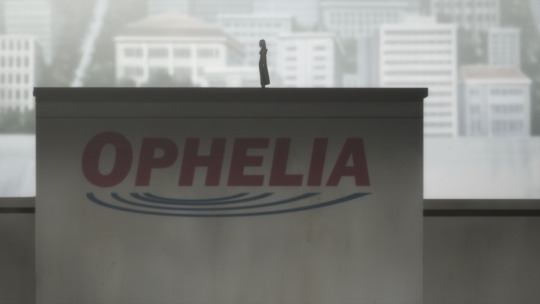








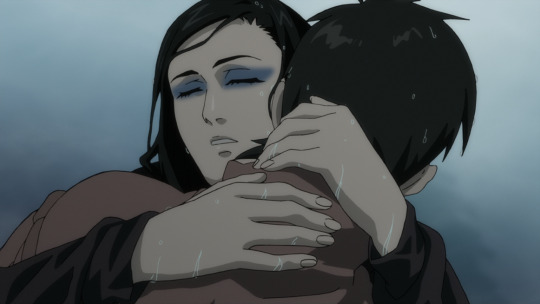

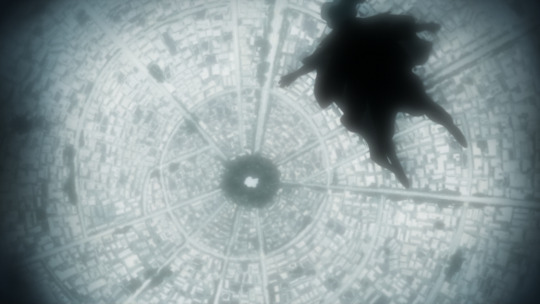



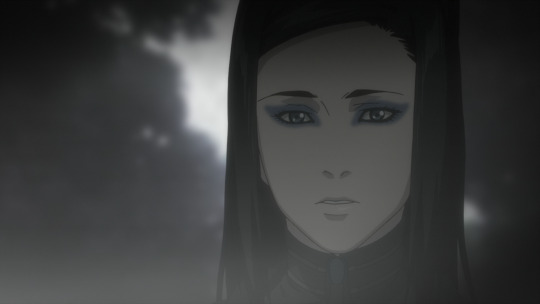




An episode that obviously stands out from the others, with Murase himself as the storyboard artist. A very powerful episode, I felt like it had been made just for me lol. It's an episode I’ll likely rewatch from time to time…
51 notes
·
View notes
Text
Ergo Proxy References and Parallelisms Vol. II
Hello there and welcome back to the Compilation of Ergo Proxy's references and parallelisms with other forms of art Literature, Cinema and Music. On this volume I'll attempt to expand on other parallels between this anime and other classical works of culture.
Some interpretations here will be highly speculative, and whether the connections were intentional or no, it's not entirely clear in every case.
Further updating and editing will come soon as part of the maintenance o this post.
As always, thank you for reading.
VOLUME II:
- Meditatio XI In the White Darkness - City Lights Bookstore - Les mémoires d'un saint - Apollo et Artemis - Ophelia - 2001 Space Odyssey - Amrita - Blade Runner - Eine Klein Nacht - A Minoan Tragedy
In the White Darkness

Meditatio XI is titled just like the interactive multimedia poem created by Reiner Strasser in collaboration with M.D. Coverley (Marjorie Coverley Luesebrink) over a 9-month period in 2003-2004. Just like the episode is an exploration on the nature between the self and the memories, and the recollection (anamnesis) of Vincent's Experieces, this visual poem explores the nature of memory, particularly focusing on the experiences of individuals with Alzheimer's or Parkinson's diseases.
"ii — in the white darkness" was originally published in January 2004 on Strasser's website. It has been preserved using Ruffle by the Electronic Literature Lab in February 2021, ensuring its continued accessibility (LINK).
Note: This is my favorite episode of the serie, so, perhaps I'll dedicate it a disproportionately long dive in, when compared to the other episodes.
CITY LIGHTS BOOKSTORE
City Lights Booksellers & Publishers was established in 1953 by poet Lawrence Ferlinghetti and Peter D. Martin, and is an independent bookstore and publishing house located in San Francisco, California. Renowned for its commitment to world literature, the arts, and progressive politics

On the series, is the (mental) place that Vincent visits while he is lost on Meditatio XI.
Perhaps a sort of involuntary Mental Palace for his knowledge to be guarded. But, this time, He is lost, and the books are empty.
Les mémoires d'un saint
This one I don't feel is an intentional example, but I believe is worth mentioning.
The Memoirs of a Saint is a 1960 painting made by the french René Magritte, that features a stage-like setting with three monumental curtains, the central one filled with an image of a cloudy sky, creating this self contained contradiction between the interior and exterior, alluding perhaps to the internal contemplative stage of the mind.
This introspective exercise is actually the core of Meditatio XI and as so, is echoed over and over again as Vincent Law unravel his own persona to uncover Ergo Proxy as his concealed identity, buried in his unconscious as the product of a self-inflicted amnesia.


Yet another layer of the Blue Sky Theatre is the revelation that of the Deus Ex Machina in the homonymous Meditatio XXIII, on which even Ergo Proxy is revealed as a fabrication of the vengeful Proxy One, who sits under the representation of a blue sky (The same beams of light foreshadowed on the Proxy's Mind Theater are actually the cause of the demise of Proxy One). And with that the oneness of the individual is reconstructed and the discernment between outside and inside is disolved.


MEDITATIO XXIII: DEUS EX MACHINA
EXTRA: A quote
JJ (JJ本屋) quotes James Alonzo Bishop
"the future is an opaque mirror. Anyone who tries to look into it sees nothing but the dim outlines of an old and worried face." Jim Bishop, New York Journal-American, March 14, 1959
APOLO and ARTEMIS... and Heraclitus
On the Library there are two marble statues:


Apollo Belvedere
A 2nd century A.D. Roman copy of an original bronze statue created between 330 and 320 B.C. by the Greek sculptor Leochares.
and

Diana of Versailles
Another partially restored Roman copy (1st or 2nd century CE) of a lost Greek bronze original attributed to Leochares, c. 325 BCE.
The "Logos" or "meaning" behind this peculiar choice of symbols requires the conciliation of opposites through the interplay of meanings and the tension of words.
Artemis and Apollo, as twin deities from Greek mythology, are rich with symbolic meaning, representing complementary dualities and a harmonious balance of opposites.
Artemis is often associated with the moon, symbolizing intuition, mystery, and the subconscious. As a huntress her instrument is the bow.
Apollo represents the sun, symbolizing clarity, superego, reason, and illumination. His light drives away shadows, suggesting knowledge triumphing over ignorance. As a musician his instrument is the lyre.
The pulsation of a string in one is a weapon, an instrument of death, and on the other is the product of the death of an animal, but an instrument of joy. Is interesting to notice that in a polysemic sense the greek word bios can express the nuances behind the symbology conveyed on this Meditatio. Biós (βιός with the accent on the O) is the Greek for "bow". Bίοs (βίος with the accent on the I), is the Greek for "life". The Greek philosopher Heraclitus was aware of this conception and used them to express his dialectical views of nature. for him, and through him, other philosophers and thinkers did too:
"The bow's name is life, but its work is death." [source]
On the same way, the secondary creator, Ergo Proxy, builder of Romdeau, is the "Agent of Death".
The irony is that the very Title of this Meditatio, "In the White Darkness", exposes this internal but revealing contradiction.
Following the previously exposed is worth noting that the solar and lunar duality of those greek deities was a motif that also appeared on previous episodes in the shape of Senekis and Kaskis, the lover proxies from the double dome of Charos and Asura. The love between them, and the compulsive strife of their forces to annihilate mutually (enabled by the Pulse o the Awakening) gave them purpose and meaning, and motivated the absurd state of war among their respective citizens. The decaying halves of a same dome was on an insatiable conflict between parts de-voided of all human-like traits: The Knights droids vs the soldiers of the last War Battalion.
In the own psychological world of Vincent/Ergo, the amnesiac dissociation of his persona that fractured the interplay between anima and animus, between his two halves, can only be resolved by the integration and recognition of himself as a whole.
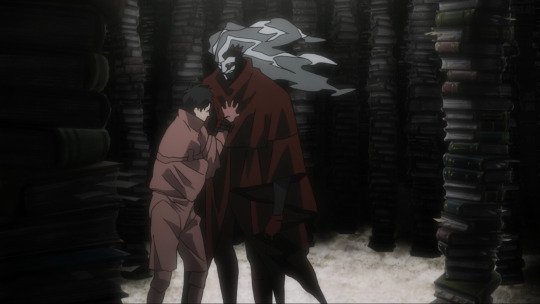
I think, therefore I am. I think therefore you are I am you. You are me
Ophelia

Ophelia is the title of the Meditatio XIV. On this episode, the protagonists arrive at an abandoned dome named Ophelia, with a mall of the same name to replenish their supplies. Unbeknownst to them, the dome's Proxy, capable of shape-shifting, subjects them to a series of illusions, delving into their psyches.
On the episode there is another obvious reference to Shakespeare's Ophelia

This is a direct nod to the Ophelia, as depicted by Sir John Everett Millais on a painting made on 1821.

2001 Space Odyssey
On the Show of Meditatio XV, some visual references to the classic film can be drawn. For Example the reference to the use of tools as bones, and the parallels between this first and last tool:



The Boomerang Star
AMRITA

As stated on the show, the biological material that forms the proxies it's called Amrita, a sanskrit term (अमृत) analogous to the greek amaranthos (ἀμάραντος) that means "immortal", "never-dying". It is a central concept within Indian religions and is often referred to in ancient Indian texts as an elixir, is comparable to the ambrosia of the greeks that also was related to the inmortality.
Amrita Cells lacks a Hayflick Limit (the he number of times a normal somatic, differentiated human cell population will divide before cell division stops) and so, they are essentially able to regenerate endlessly.
Blade Runner Death
Both Amnesia and Dr Eldon Tyrell from Blade Runner are blinded and killed by the same way: eye crushing. Dr Eldon Tyrell is the creator of the Nexus-6 Models on Blade Runner. Amnesia is the guardian of the memories of Mosko Dome, and stores the memories of Ergo Proxy.


EINE KLEINE NACHTMUSIC
On Meditatio XX, when Dedalous, Re-L and Swan are dinning, the classical piece playing is the second movement of Eine kleine Nachtmusik in G Major, K. 525, Romanza, quite popular for appearing on Alien The Eight Passenger.

A Minoan Tragedy (Kind of...)
Daedalus Yumeno (デダルス・ユメノ) is quite and interesting choice for the name of the Welfare Bureau. Both characters are brilliant on their fields and the bold approaches they apply to their schemes.
Deep is their hubris too, and their desire to shape the world to their whims. Both the mythological character and his anime homonym defy the natural order and provide the aid with the genetic experimentation. The first is the responsible of aiding Pasiphae to get pregnant by the White Bull (act that created the hybrid now called The Minotaur), and the second one is responsible for the cloning of Re-L Mayer and the hybridization between a Re-l and Monad Proxy. Also it's the mind behind the attempt of make the inhabitants of Romdeau able to reproduce again.
Beyond the name, that, Daedalus Yumeno is also surrounded by minor minoan references, as this dolphin on his holographic aquarium that comes straight from the early minoan paintings on the Crete Palace.

And there's also... The Thread

On greek myths, Daedalus provides the princess Ariadna with a ball of thread to help Theseus to navegate the Labyrinth. On the other hand Daedalus Yumeno gave REAL/Monad a ball of red thread for her to make easier to find her.
Eventually, on Meditatio XXIII, REAL/Monad takes the role both of Icarus and of Ariadne, but Daedalus Yumeno don't stand her abandoning him (again) for Vincent Law/Ergo Proxy, and destroys the Dome.
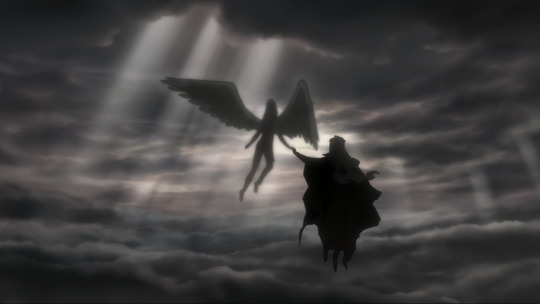
Ergo Proxy (our Theseus) then confronts his original, Proxy One (The Minotaur), and it's brought out of the crumbling dome by the now Winged ReaL/Monad.

But as most proxies, ReaL/Monad has a fatal weakness on her design, she is vulnerable to the sunlight and the UV rays. Thus, despite the warnings of Daedalus when she attempted to fly to close to the sun, she dies disintegrated, just as when Icarus tries to fly too high and close to the sun, his wax wings melts and he falls into the ocean.
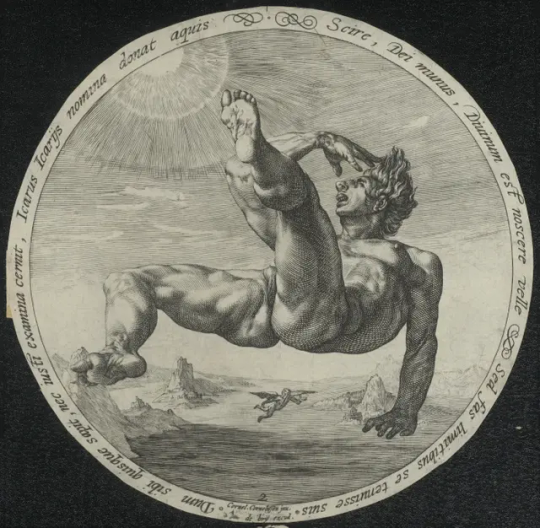
Fall of Icarus, ca. 1588 from a series of The Four Disgracers. Engraving by Hendrick Goltzius
11 notes
·
View notes
Text
Ergo Proxy References and Parallelisms Vol. I
This is the first (and maybe only) post of a Compilation of Ergo Proxy references and parallelisms with other forms of art Literature, Cinema and Music. On this Volume:
𝟙𝟡𝟠𝟜: ℙ𝕒𝕘𝕖 𝟙𝟘𝟙
𝚃𝚁𝙸𝙽𝙸𝚃𝚈
𝕿𝖍𝖊 𝕺𝖉𝖊𝖘𝖘𝖆 𝕾𝖙𝖆𝖎𝖗𝖈𝖆𝖘𝖊 𝕾𝖈𝖊𝖓𝖊
In Memory of Willie McCool
FOLLOW THE WHITE RABBIT
A Map of Historical Figures
The Film and the Public
Cruxified Snake
Centzon Tōtōchtin
L'Homme qui Rit :D
A House of Cards
ₜₕₑ ₜᵣᵢₚₗₑ Gₒddₑₛₛ?
Drifting into the Attack
RE-L 124C41+
𝟙𝟡𝟠𝟜: ℙ𝕒𝕘𝕖 ��𝟘𝟙
From Re-l's notebook a handwritten page can be seen in the first minutes of Meditatio I, those notes being:

flipping the image a few phrases can be read as: "The Party", "the legendary Brotherhood exist" "no way of coming together" "the force to destroy"
The source material is George Orwell's 1984, chapter I:
If there was hope, it must lie in the proles, because only there in those swarming disregarded masses, 85 per cent of the population of Oceania, could the force to destroy the Party ever be generated. The Party could not be overthrown from within. Its enemies, if it had any enemies, had no way of coming together or even of identifying one another. Even if the legendary Brotherhood existed, as just possibly it might, it was inconceivable that its members could ever assemble in larger numbers than twos and threes. Rebellion meant a look in the eyes, an inflexion of the voice, at the most, an occasional whispered word. But the proles, if only they could somehow become conscious of their own strength. would have no need to conspire...
𝚃𝚁𝙸𝙽𝙸𝚃𝚈
The parallels between The Matrix and Ergo Proxy are beyond the merely atmospheric. The similitude between their female protagonist, Re-L Mayer and Trinity, are quite popular domain in sci-fi fan circles. Not just the gothic-esque choice of black as main wardrobe color, but being essential for the main protagonist (Vincent Law and Thomas Anderson/Neo, respectively) who is also The One.
It's later revealed in both franchises that their female co-protagonist is essential in a long standing plan.

Meditatio I: Re-L pose for shooting an Enemy AI (an infected Armed AutoReiv)

The Matrix - 1999 Trinity's iconic "Dodge this!"
𝕿𝖍𝖊 𝕺𝖉𝖊𝖘𝖘𝖆 𝕾𝖙𝖆𝖎𝖗𝖈𝖆𝖘𝖊 𝕾𝖈𝖊𝖓𝖊/ Потьо́мкінські схо́ди
Almost 100 years have passed since the iconic scene from Sergei Eisenstein's 1925 silent film Battleship Potemkin, and the scene is still present in cinema tropes. There are thousand examples of versions of this scene:

The Potemkin Battleship - 1925

Meditatio II: the carriage of Raul Creed's Son
In Memory of Willie McCool
Willie McCool was an American naval officer and aviator, test pilot, aeronautical engineer, and NASA astronaut, who was the pilot of Space Shuttle Columbia mission STS-107. Willie and the rest of the crew of STS-107 were killed when Columbia disintegrated during reentry into the atmosphere.
He's mentioned on several screens throgout the series, as well as the statue made in his memory at Lubbok.

Meditatio III: The filler text is all about McCool.
As an extra: McCool favorite band was Radiohead. The song Fake Plastic Trees, was also used as a Wake Up Song during the STS-107 mission.

FOLLOW THE WHITE RABBIT
On Meditatio III, VIncent tries to escape the hellish network of tunnels, maintenance routes and underground spaces that hold Romdeau. He's aided by the charismatic, now Cogito infected, Auto-rave Pino, with her cute pink rabbit pijama, in a somewhat allusion to Alice in Wonderland's White Rabbit.

White Rabbit as depicted in John Tanniel's illustrated version of Alice in Wonderland - 1869

Meditatio III: Pino Leading Vincent using the escpae route of the infected autoraves
Pino is later seen reading Alice in Wonderland and Alice Underground.

Meditatio VIII: Illustrated coloured copy of Alice in Wonderland. Illustrations by John Tenniel. Tematically, on this episode the encounter the remains of dome Charos (ハロス). The humans inhabitants of Charos are consumed in a sanguinary conflict with the residents of their twin dome Asura, following the nonsensical commands of their respective Proxy, not very different to the way the commands of the Red Queen were nonsensical.

Meditatio XVI: Pino Reading Alice Underground
A Map of Historical Figures
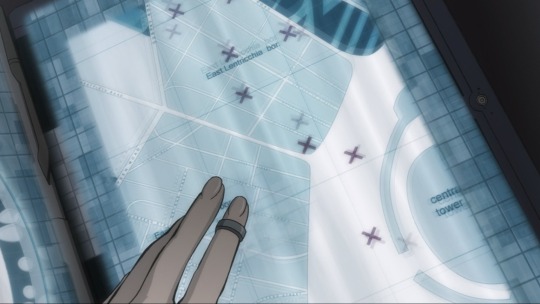
On Romudo City, structural urban features receive the names of relevant historical writers and philosophers. The City is divided in at least nine sectors, several boreaughs, seven islands and the Mainland that holds the Central Tower of the Dome.
As seen in the city map, some streets, boroughs and parks are named after famous figures of western history, particularly literature and philosophy.
Due to the quality of the screen, a few of the names are not visible.
The most notable references are:
Rousseau Street as an homage to Jean Jacques Rousseau
Mainland Descartes as an homage to Rene Descartes
Machiavelli Road as an homage to Niccolo Machiavelli
Montesquieu Road, Louis Street, Charles Street and Secondat Street as a references to Charles Louis de Secondat, baron de La Brède et de Montesquieu
Schopenhauer Road as an homage to Arthur Schopenhauer
George Street intersecting Berkeley Street, as a reference to George Berkeley.
East Lentricchia borough Named after Frank Lentricchia
East McLaughlin borough (possibly named after Dean Benjamin McLaughlin, or his son Dean Benjamin McLaughlin, Jr.)
Giambattista Road intersecting Vico Street in honor of italian writer Giambattista Vico
The East Islands are named:
Island East Gottfried, Island East Wilhelm and Island East Leibnz in honor to Gottfried Wilhelm Leibniz
The Film and the Public


Pino's unstoppable creativity is expressed on a drawing over one of Hoodie's book: The Film and the Public, written by Roger Manvell. The book aims to provide insights from both the filmmaker's and the audience's perspectives, making it a valuable resource for understanding the multifaceted nature of cinema in the mid-20th century. (That might explain some other references to XX century cinema)

Cruxified Snake
No copy of the book The Film and the Public I've seen have an illustration of a snake in a cross. That old alchemical and esoteric symbol is related to "fixing the volatile" and also The snake on the cross is a symbol of the crucifixion of Christ and the healing of sin.

Centzon Tōtōchtin

The ship that Pino and Vincent use to travel to Moscu is called "centzon tōtōchtin" or the 400 Rabbits, in reference to the aztec deities that are a group of divine rabbits who meet for frequent drunken parties.
Other minor characters in the series, particularly in Meditatio VIII have also names related to the deities.
Patecatl is the name of the commander of the fortress, whose people have been fighting for many generations with an army of self-reliant knights (they are called asuras).
Omacatl is the senior officer (lieutenant) of the fortress.
Mayahuel is a woman imprisoned in a prison (basement of a fortress) for her madness, in which she speaks of the moonlight, the “Master” and the impending fight.
On the myths:
Mayahuel – originally a goddess of fertility; patron of the drink octli, personification of the agave. From the marriage of Patecatl and Mayahuel were born the 400 rabbits.
Omacatl is the god of feasts and pleasures.
Patecatl – the god of healing, medicine, fertility and the alcoholic drink of agave, octli, the husband of Mayahuel.

Misquoting Victor Hugo
Just after rescuing Vincent and ten days after, Hoddie is reading aa book while quoting what he then attributes to the french poet Joë Bousquet:
Nothing there was a town, or a church, or a river, or a color, or a light, or a shadow. I kept still for a while and felt a pleasant sensation as the indescribable great harmony the brightness of the sky and the melancholy of the moment spread throughout my body.
But this is actually a quote from Victor Hugo's Voyage et Excursions : Nemours », Œuvres Complètes, t. 2
Tout cela n’était ni une ville, ni une église, ni une rivière, ni de la couleur, ni de la lumière, ni de l’ombre ; c’était de la rêverie. Je suis resté longtemps immobile, me laissant doucement pénétrer par cet ensemble inexprimable, par la sérénité du ciel, par la mélancolie de l’heure. Je ne sais ce qui se passait dans mon esprit et je ne pourrais le dire ; c’était un de ces moments ineffables où l’on sent en soi quelque chose qui s’endort et quelque chose qui s’éveille.
While he still insist that the book is from Joë Bousquet, it is actually Victor Hugo's
L'Homme qui Rit :D

Victor Hugo's The Man Who Laughs, as seen in Meditatio IIII
The Man who Laughs is the story of Gwynplaine, who has a disfigured face and is torned between the society's expectation and his true nature.
The book has many adaptations over the years, but notably 1928's was the mos influential one, particularly for Conrad Veidt's performance as Gwynplaine.

Conrad Veidt's Gwynplaine. 1928
Among other things it inspired The Joker, from DC Comics, and also the Original Design of Ergo Proxy...
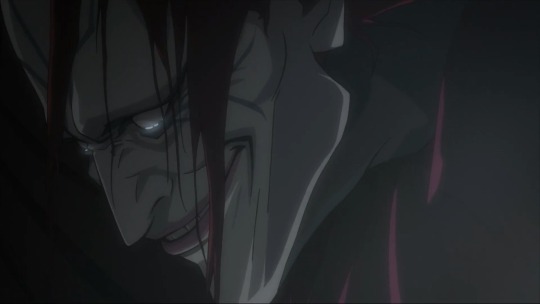
Ergo Proxy as seen in the Pilot Trailer
A House of Cards
Just as in the illustrations of John Tenniel previously showed, the cards that unveil at the End of Meditatio VIII are all spades

Is this a good hand?
Note: Spades are associated with mental struggles in minor arcana.

Kaskis pulls out a Joker card, conveniently similar to Ergo Proxy . Meditatio VIII
ₜₕₑ ₜᵣᵢₚₗₑ Gₒddₑₛₛ?
On the decoration of Charos Dome, the symbol of the city closely resembles the mark of the Triple Goddess, a lunar female deity with interesting nexus with Robert Graves' studies on religious archetypes and myths of Europe.
Senekis being the "Agent of the Moonlight" is strongly associated with the moon.


Meditatio VIII
Drifting into the Attack

This is a quite obscure one, from Meditatio XI and I actually can't find the proper source to this one. My main suspect is that is a reference of a song played by Allan Holdsworth and Gary Husband on a live presentation at 1982. Here is a youtube link into the song.

In the Left corner there's a book titled "Drifting into the Attack"

Allan Holdsworth appears later on a text wall on Meditatio XVII, that quotes an article about the musician from All About Jazz.
Beyond his ability in improvising mercurial solos and sculpting the guitar's voice into an ever-expanding range of textures and colors, Holdsworth has dedicated his energies to develop many different aspects of guitar technology. This has included new “baritone” variations of the instrument, his own custom 6-string designs (one most recently manufactured by Carvin), the invention of electronic components for the recording studio, and exploring the possibilities of guitar-based synthesizer controllers. Holdworth's ability to improvise over complex and challenging chord voicings always reveals a deep emotional base and a strong, imaginative personality that is as instantly identifiable as any among Holdsworth's generation of guitar and jazz masters.
RE-L 124C41+
Re-L Mayer current version is named as 124C41+ in reference to Hugo Gernsback's novel Ralph 124C 41+: A Romance of the Year 2660, written in 1911.


This if the Fake Death Certificate of Re-L Mayer as shown on Meditatio VII
NOTE: There's a problem with the visualization of the Street name list.
18 notes
·
View notes
Text
[Re-L Notebook]
Stanley Donwood's Notes and Stories
Ergo Proxy characteristics barren landscapes, palimpsest of self-questioning anguish for a true place in the world, mechanistically oppressive societies and grayish palettes are very rotted on the cultural imagery of artistic projects of early XXI century. Aesthetically this anime is not alien to the influences of these currents of thought and production, on their relatives niche; from alchemy and the subconscious to the dystopian soundscapes of Radiohead.
And considering the latter, is perhaps no coincidence that the ending of the series was no other than "Paranoid Android".
But another link to the band was there, hidden. On Meditatio XVI, where Re-L, Pino and Vincent got stranded on a desolate field of nothing, waiting for a breeze and grasping their sanity as the days passed by and resources started to get scarce. Re-L keeps a journal where she pours her feelings, thoughts and notes on the increasingly confusing world they inhabited. This is also a very interesting and subtle way to refresh avid viewers the information that was just revealed.

Among the notes concerning the nature of proxies and amrita cells, some passages had a familiar structure. And the author of that sequences of words was no other than Stanley Donwood, creator of Radiohead's artwork (and many other projects from Thom Yorke).
So... Eureka!
That was the missing link. The taste of the producers and the artists behind the anime all poured as subtle references to the works they admired and degusted.

So my search started with this note. and by words sequences it was particularly easy to find the source as some of Stanley Donwood's short stories:
Trouble with the Neighbours.
Aliens Again
Big Bird Story
A Man who thinks he is a Pig
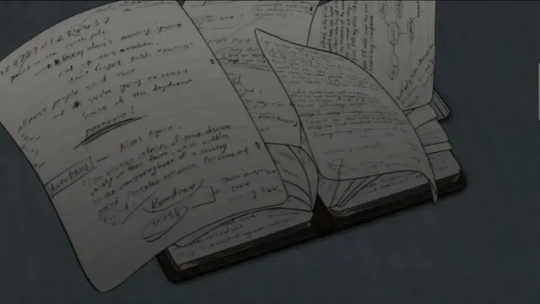
At some point I realize the diary looked like the same three stories written over and over again... at least at this particular timestamp

Then there's this sets of pages:
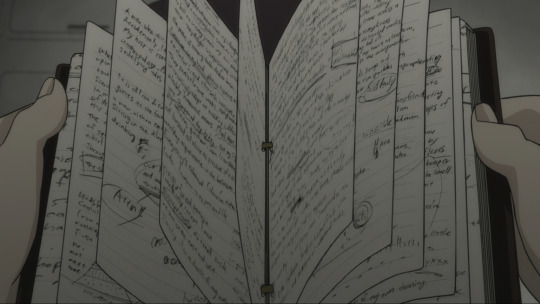
more clearly seen as

That comes from the story:
Game
EXTRA:
There's also a portion of the lyrics of The Land of Plenty, by Leonard Cohen
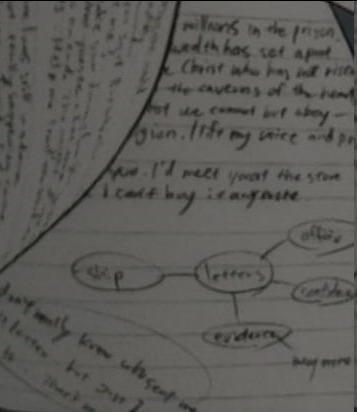
For the millions in the prison That wealth has set apart - For the Christ who has not risen From the caverns of the heart - For the innermost decision That we cannot but obey - For what's left of our religion I lift my voice and pray: May the lights in The Land of Plenty May the light in The Land of Plenty May the light in The Land of Plenty Shine on the truth some day I know I said I'd meet you I'd meet you at the store But I can't buy it, baby I can't buy it anymore
Still Missing

One of the pages has a text that I cannot find the source to. It looks like the lyrics of a song. As usual: Thank you so much for reading this far
17 notes
·
View notes
Text
Ergo Proxy: Gregorian Chants
This is a short one... And So far the best fit I can find for being the source of gregorian chants samples of Ergo Proxy is the 2001 album Sacré Coeur - Orgue et Chant grégorien de l'abbaye de Fontgombault.
Some pieces are sampled on Yoshihiro Ike's soundtrack , particularly Sanctus II on the theme New Pulse.
Thanks for reading
:D
3 notes
·
View notes
Text
Ergo Proxy: Paintings
A certain number or paintings appears throughout the series as the decoraion of interiors scenarios are decorated with paintings and other artworks. Notably Kaskis Residence and Raul Creed's office and house, and City Light Library.

From Meditatio XXII, three paintings appears at Raul Creed's house

Raul Creed's office, as seen in Meditatio II

Kaskis' Dinning room, as seen in Meditatio IX
The paintings is
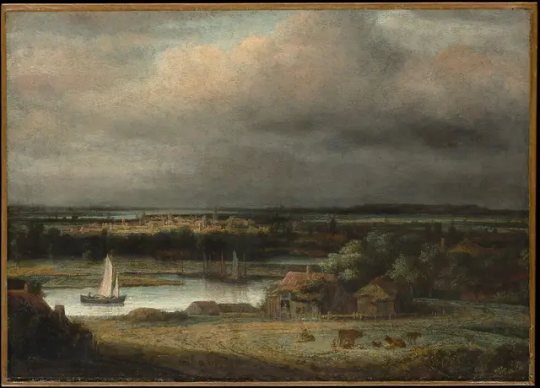
#1: Landscape with a wide river, by Philips Koninck, made in 1648 or 1649, and currently at the Metropolitan Museum of Art, New York. Is actually one of the first works and was inspired by the landscapes of Rembrandt.
The other painting and usually cropped is...
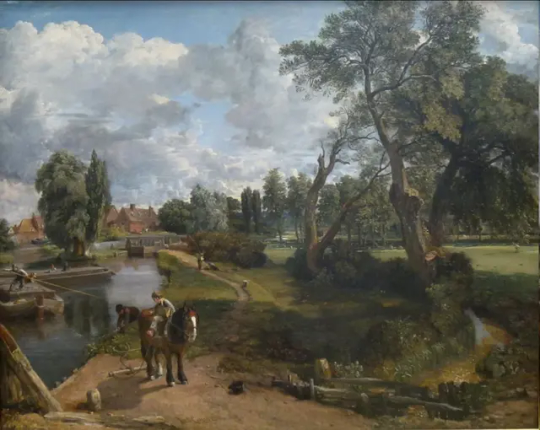
#2: Flatford Mill, by John Constable, 1816. It depicts a view of Flatford Mill in East Bergholt on the River Stour. Also,

Meditatio IX

#3 Gezicht op Delft, made by Johannes Vermeer (1659 - 1661)
The painting of the Dutch artist's hometown is among his best known, and his only cityscape.
... and for meditatio XI:
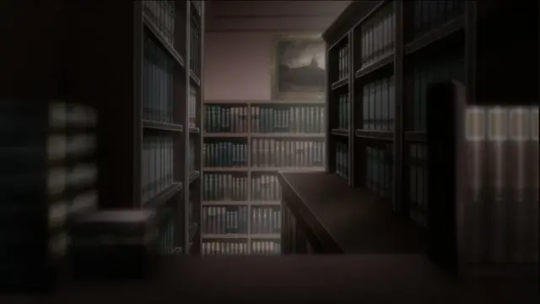

#4 The Mill, made by Rembrandt Harmenszoon van Rijn, around 1645 - 1648
EXTRA:

Not exactly a painting but a nice detail from Daedalus Yumeno's fish tank screen on Meditatio XVIII

Minoan fresco of Dolphins and other sea creatures on the Minoan palace of Knossos, Crete. Made around 1700-1450 BCE
Note: On greek myths, Daedalus created the Labrinth of Crete, and was prisoner there for several years.

Next scene Monad/Re-L is seen playing with a red thread ball in an obvious reference to the myth of Ariadne's Thread
There's another three painting I'm not able to identify yet:

The Small painting of a saint in blue drapes on te right inferior region. Meditatio XXII
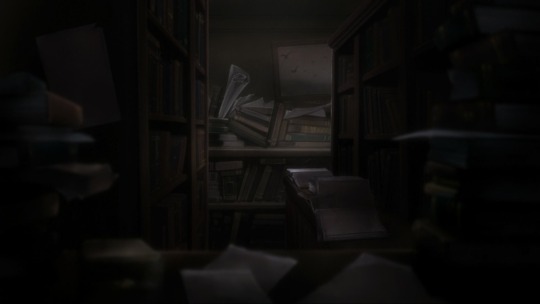
The painting of birds flying over a field on Meditatio XI

This cropped painting from the Security Bureau on Meditatio XVII
As I keep finding these details I'll update the post Thank you for reading so far. ADDENDUM
Thanks to Guardianofinghtmares for finding the right source of the missing painting on Raul's house. Let me introduce you to Proserpine, one of the eight versions painted by the pre-raphaelite artist Dante Gabriel Rossetti.


Personal note: Kudos to @guardianofnightmares for finding that painting using just that little portion of the visible canvas.
45 notes
·
View notes
Text
Ergo Proxy Opening: In search for the artwork's source
Ergo Proxy's Opening is a fascinating piece of artwork characterized by it's kaleidoscopic mix of scenery, images from the series and subtle references to pieces of art and literature. The whole design reminds me a bit of the style of Kyle Cooper in intro sequences like Se7en . Some are very clear while others are quite cryptic and frankly unreadable. This post will summarize a few of those references and their sources:
Holy Images
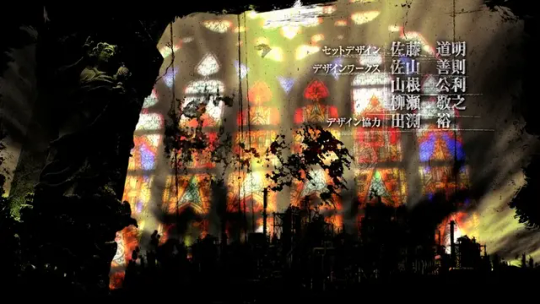
First we have the apparition of some glass panels and a statue in a column, and the image of some industrial complex. The statue have a chalice and appears to be a young man, and an eagle at his feet. Those are the attributes of Saint John the Younger. With that in mind, the search was easier... and after almost 14 hours of reading and searching, I found two of the three artworks.
Both the statue and the stained glass comes from the The Cathédrale Saints-Michel-et-Gudule at Brussels.
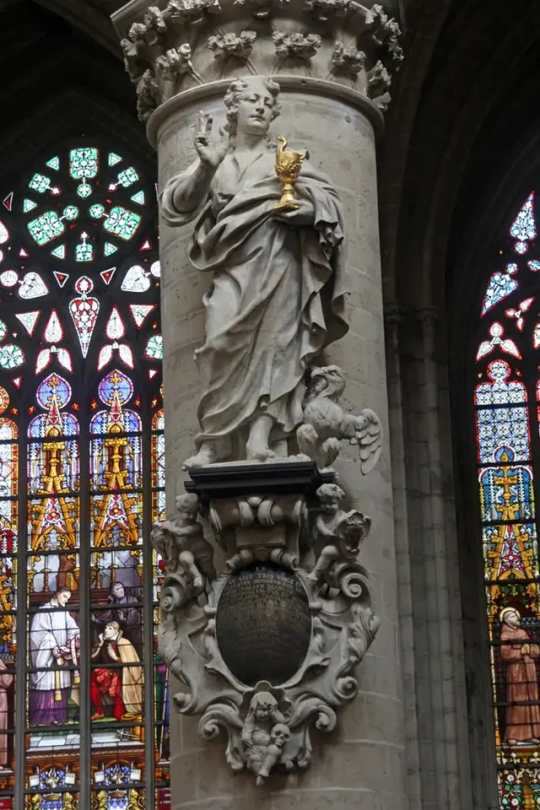
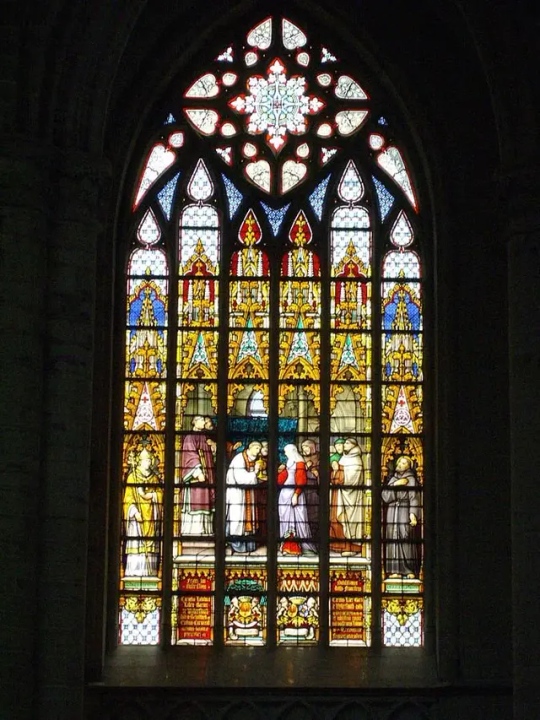
Stained Glass, probably made by Jean-Baptiste Capronnier (c. 1870):
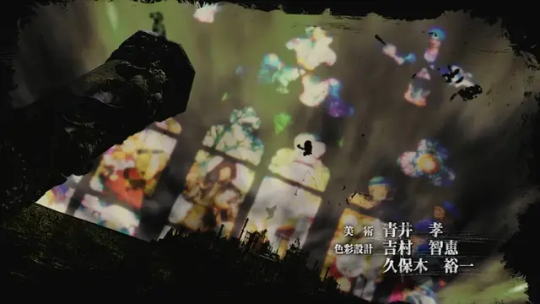
Another decorated window appears, this time with a more modern artwork. The decorated window was designed by Alfons Mucha, c. 1930, for the reconstruction work for St. Vitas Cathedral in Prague.
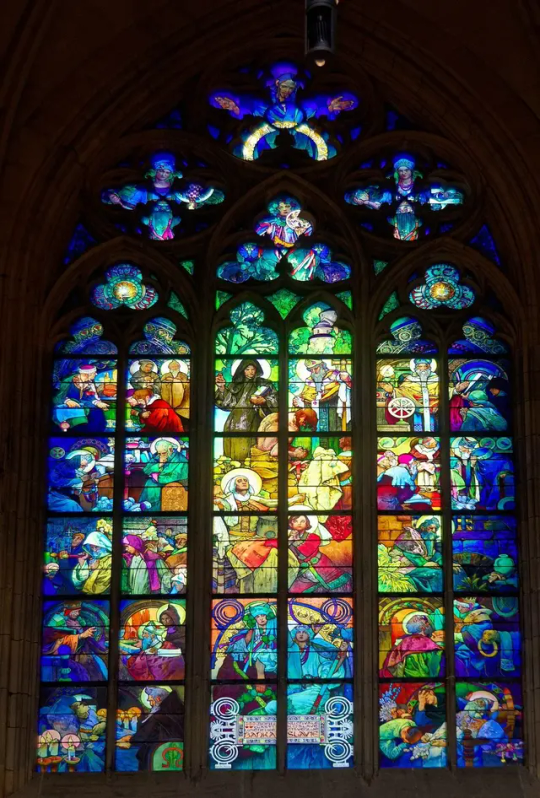
The Power of Seven and the Lapis Philosoficus
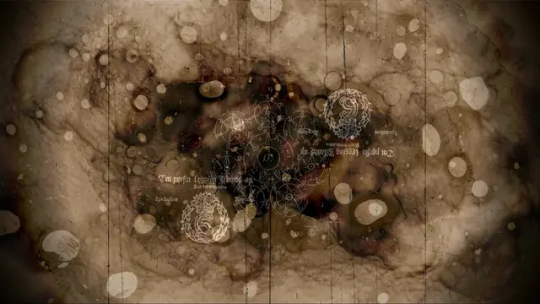
The occasional image of complex astrological or alchemical heptagrams flashes many times during the opening, being this one the most clear snap I could get. The text in the center of it reads "Ma Te Ri A Pri Ma *" that confirms the alchemical nature of the illustration.
After many attempts to find the source of the illustration i had to dive into my older alchemy notes. Suddenly I remember the works of a notorious alchemist obsessed with number seven, none other than Sir Isaac Newton. And Eureka!
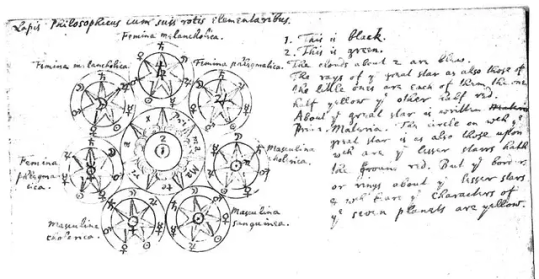
the image comes from a set of notes on the processes behind the achievement of the philosopher's stone, titled "Lapis Philosophicus cum suis rotis elementaribus" and dated to c. 1690
Landnámabók
Some of the decorations that appears on the opening comes directly from the icelandic text of settlers, a medieval Icelandic written work which describes in considerable detail the settlement (landnám) of Iceland by the Norse in the 9th and 10th centuries CE.
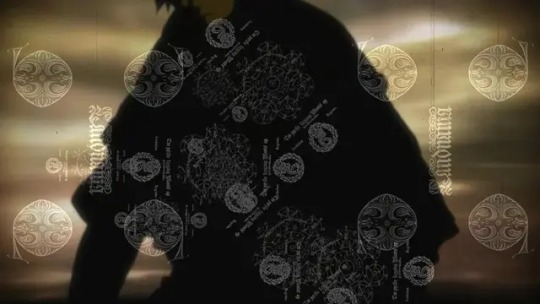

La Glorification de l'Art

This one was relatively easy to find. It is a quite common allegorical representation.

The building housing the Royal Museum of Ancient Art in Brussels is a masterpiece designed by Alphonse Balat, the Court's favorite architect, the sculpture flanking the main entrance is the work of Paul de Vigne, and was made around 1885. La Glorification de l'Art depicts Art as a winged youth, accompanied by Glory and Fame. It also appears on the opening. Art, represented by a winged man, receives from the hand of Glory a palm and a crown; while the Fame, with trumpet and bumper, publishes her exploits.
Rhyme 247
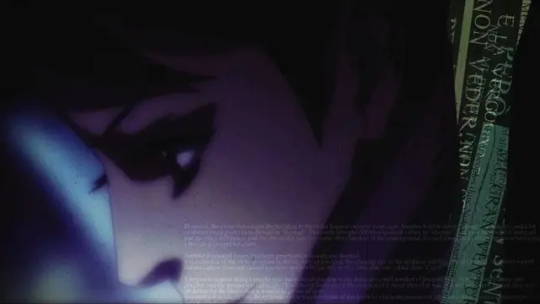
notice the words on the right side of the screenshot: "e vero", "Non Veder" "Gran Ventura"
Michelangelo Buonarroti was an exceptionally good artist, and a passionate poet too, even when he preferred to keep most of his literary production quite obscure. One of his works for the Sagrestía Nuova at the Medici Chapel in Florence was a representation of the Night, placed over the tomb of Giuliano di Lorenzo de' Medici, Duke of Nemours. Night was singularly praised by his contemporaries, especially Giovanni Strozzi, who dedicated an epigram on 1544:
La Notte che tu vedi in sì dolci attidormire, fu da un Angelo scolpitain questo sasso e, perché dorme, ha vita:destala, se nol credi, e parleratti.
Michelangelo responded in another epigram, today known as Rhyme 247:
Caro m'è 'l sonno, e più l'esser di sasso,mentre che 'l danno e la vergogna dura;non veder, non sentir m'è gran ventura; però non mi destar, deh, parla basso
This Rhyme appears on Ergo Proxy in another occasion:
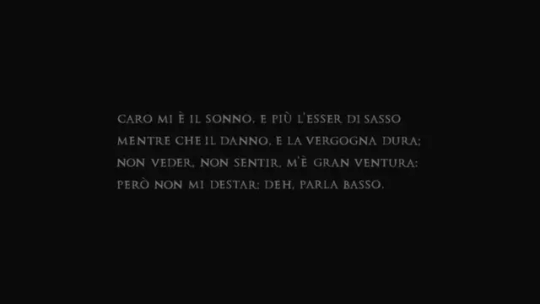
The poem as appears on the beginning of the first episode
NIGHT DAWN DAY DUSK
Donov Mayer's Collective Entourage are embodied by the four sculptures from the allegorical monument (Sagrestía Nuova) of Michellangelo. A pair of the statues were located over the sarcophagus of Giuliano de' Medici, (Day and the Night) and Lorenzo de' Medici (Dusk (or Twilight) and the Dawn) respectively. On the series, each have the name of one prominent occidental philosopher:
Lacan: as Night, Voiced by: Atsuko Tanaka (Japanese), Barbara Goodson (English)
Derrida: as Dawn, Voiced by: Yōko Sōmi (Japanese), Melodee Spevack (English)
Husserl: as Day, Voiced by: Hidekatsu Shibata (Japanese), Michael McConnohie(English)
Berkeley: as Dusk, Voiced by: Yuu Shimaka (Japanese), Doug Stone(English)

[Unknown]
Some artworks or pieces of literature used are still unknown (for me)
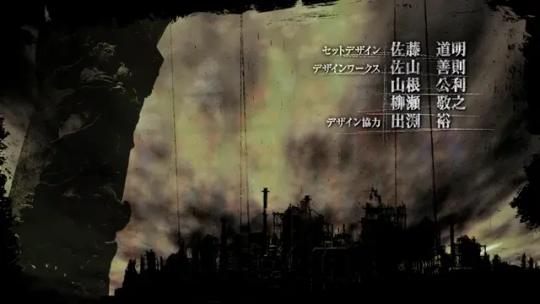
The industrial landscape
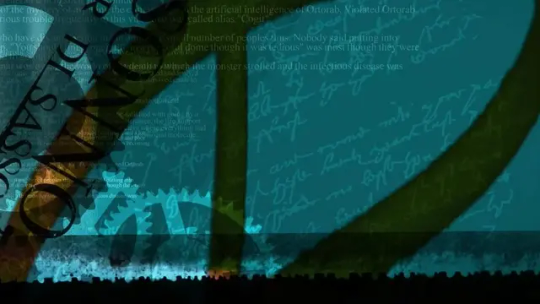
The cursive text

And this arabic/persian texts
Thank you so much for reading so far
39 notes
·
View notes




